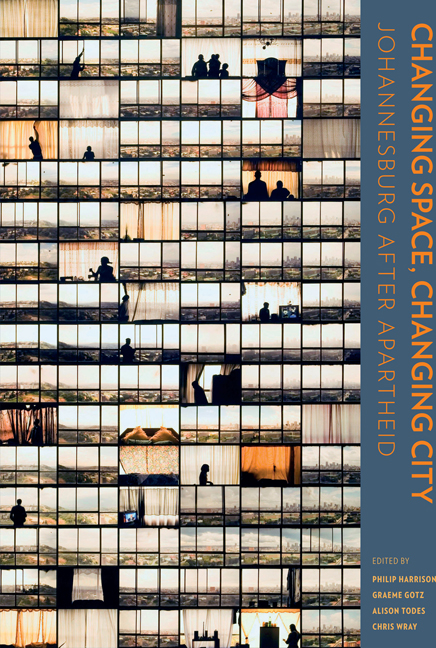Book contents
- Frontmatter
- Contents
- Preface
- Cartography
- 1 Materialities, subjectivities and spatial transformation in Johannesburg
- Section A The macro trends
- Section B Area-based transformations
- 12 Between fixity and flux: Grappling with transience and permanence in the inner city
- 13 Are Johannesburg's peri-central neighbourhoods irremediably ‘fluid’? Local leadership and community building in Yeoville and Bertrams
- 14 The wrong side of the mining belt? Spatial transformations and identities in Johannesburg's southern suburbs
- 15 Soweto: A study in socio-spatial differentiation
- 16 Kliptown: Resilience and despair in the face of a hundred years of planning
- 17 Alexandra
- 18 Sandton Central, 1969–2013: From open veld to new CBD?
- 19 In the forest of transformation: Johannesburg's northern suburbs
- 20 The north-western edge
- 21 The 2010 World Cup and its legacy in the Ellis Park Precinct: Perceptions of local residents
- 22 Transformation through transportation: Some early impacts of Bus Rapid Transit in Orlando, Soweto
- Section C Spatial identities
- Contributors
- Photographic credits
- Acronyms
- List of plates
- List of figures
- List of tables
- Index
14 - The wrong side of the mining belt? Spatial transformations and identities in Johannesburg's southern suburbs
from Section B - Area-based transformations
Published online by Cambridge University Press: 20 April 2018
- Frontmatter
- Contents
- Preface
- Cartography
- 1 Materialities, subjectivities and spatial transformation in Johannesburg
- Section A The macro trends
- Section B Area-based transformations
- 12 Between fixity and flux: Grappling with transience and permanence in the inner city
- 13 Are Johannesburg's peri-central neighbourhoods irremediably ‘fluid’? Local leadership and community building in Yeoville and Bertrams
- 14 The wrong side of the mining belt? Spatial transformations and identities in Johannesburg's southern suburbs
- 15 Soweto: A study in socio-spatial differentiation
- 16 Kliptown: Resilience and despair in the face of a hundred years of planning
- 17 Alexandra
- 18 Sandton Central, 1969–2013: From open veld to new CBD?
- 19 In the forest of transformation: Johannesburg's northern suburbs
- 20 The north-western edge
- 21 The 2010 World Cup and its legacy in the Ellis Park Precinct: Perceptions of local residents
- 22 Transformation through transportation: Some early impacts of Bus Rapid Transit in Orlando, Soweto
- Section C Spatial identities
- Contributors
- Photographic credits
- Acronyms
- List of plates
- List of figures
- List of tables
- Index
Summary
Absences and insights
The southern suburbs are the terra incognita of urban scholarship in Johannesburg. Hart (1968) dealt expressly with this part of Johannesburg and a few other contributions have provided insights into specific aspects of the history and development of the southern suburbs (e.g. Mooney 1998; Parnell 1988). The seemingly mundane spaces of the historically white working-class south have remained largely outside the purview of the academic elite in Johannesburg, who have directed their attention to either the spaces of the black working class or to the glitzy spaces of the north.
The south is the in-between space, seemingly neither poor enough nor rich enough to warrant serious attention. However, the southern suburbs offer urban researchers a wealth of insight into processes of socio-spatial development in the city. They provide an intriguing window into the social lives and identities of a diversity of groups, but also into the social and cultural construction of space. The shaping of space in the south cannot be separated from the emergence and consolidation of a white working class in the early decades of Johannesburg's mining and industrial history; the state response to an influx of largely destitute rural Afrikaners; the arrival of southern European immigrants in significant numbers from the 1940s; the rapid expansion of the white middle class in the 1950s and 1960s; the rapid expansion of a black middle class from the 1990s; and the arrival of large numbers of African migrants, including those from Mozambique, Zimbabwe, the Congo, Nigeria and Somalia.
The southern suburbs elucidate many other spatial processes shaping Johannesburg with a clarity missing elsewhere in the city. Here the spatial fragmentation of the city is barely concealed. The area as a whole retains a level of separateness that has outlasted the south's distinctive role as a space of the white working class. The suburbs are a motley, poorly connected collection of neighbourhoods, developed separately at different times, with little apparent thought for internal integration or citywide connections.
Information
- Type
- Chapter
- Information
- Changing Space, Changing CityJohannesburg after apartheid, pp. 269 - 292Publisher: Wits University PressPrint publication year: 2014
